Helen Fry
Helen Fry - ‘Future Light Cone’ Tape
Helen Fry - ‘Future Light Cone’ Tape
Couldn't load pickup availability
The uncanny is Helen Fry’s birthright: both of her parents have a twinsibling. For her, the absence of a genetic double is felt as a lack.When nature reveals itself as a master of eerie duplication, how doesone draw a line between organic and mechanical reproduction? Thus,Fry’s plea to her mother for a “Twin” becomes a technologicalproposal: “so this is the future….if we have the possibility to createfunctional 3D-printed human organs, why don’t we just print my twin?”If nature is in the business of cloning, why wouldn’t your mother have a 3D printer?
In this world, where it is hard to trace the boundaries of the artificial, a love song becomes a matter of materials science. Feelings can be confused with industrial processes. An emotion might have not only texture but extension; a sentiment might be a membrane, becoming impossibly thin. The prospect of lost passion shades into the promise of a technological miracle. It’s hard to tell whether the request to “turn me on” in “Maybe Not” is a come-on or a friendly computer instruction, robotically repeated. It’s not made any easier by the dispassionate phrases spoken between the choruses: “a sensible desire, a vulnerable reflection.” Is a lover another kind of twin? If yours was 3D-printed, could you tell?
What does all of this actually sound like? Well, beautiful. (The arpeggios of “Plasticine,” a standout on the second volume of the Mansions and Millions label mixtape, might make one teary-eyed.) Technological alienation is an easy theme to find in music today; Future Light Cone distinguishes itself as music for technological domestication, music of the cyborg hearth. Fry’s Classical background comes through in her organ and harpsichord-invoking synth pads, but the tones don’t aspire to an organic realism; nor are they self-evidently artificial. They simply are themselves, comfortable and elegant like a worn-in but finely-crafted set of furniture. On “PCNC 310,” a fantasy about an unstopping milling machine, with Fry (who is also an industrial designer) repeating a priestly intonation of the device’s name and MS-DOS entry code, one can imagine the heavy-duty machine tool positioned in a living room, next to an antique sofa and a loom. That domestic feel likely has a lot to do with how the EP came about. Fry and her collaborator Rémi Letournelle, (of the band Slow Steve) who played on the record as well as producing and mixing it, retreated to a rural east German home to work on Fry’s demos. There they incorporated the setting’s prosaic elements into the recordings, using baskets, cotton swabs, and a neighbor’s cat.
The term ‘future light cone’ refers to the region of space and time that a beam of light will travel through in its lifetime. It’s a nice metaphor for an EP which sees the future unfolding in front of it and takes in all its strangeness with equanimity and poise.
Share



